FOX RED LABRADORS |
My interest in the fox red shade of labradors began when I was researching the colour genetics of the breed. Prior to that, I had never seen the shade, nor understood its origins. The more I found out about the shade, the more I became driven to try and integrate the shade into my breeding program. Thanks to Audry Steelman of Blackfork Labradors, USA, I was able to import my 2 very special red girls, Sunnie and Cherry. My aim is not to exploit the colour or to merely breed for colour alone. I am carefully selecting breeding partners for the girls that will improve type irrespective of colour. Over time, I hope to see the red shade accepted and represented in NZ homes and also in both show and field. Below is information about the fox red shade. I invite you to read it and then make up your own mind on this delightful shade of our labradors. |
|
Well Known Fox Red Labradors of TodayIn the USA and since the 1980's in Europe, fox red and dark yellow labradors have not done too well in the show ring. It is an uphill battle for several different reasons. In the UK, over the years a few dark/red champions have been made up like Lady Barlow's CH Knaith Beatty [1965 - 1979], Lady Barlow and Felicity O'Brien's CH Castlemore Martin WC, CD [1975 - 1990], Lady Barlow's CH Valleyview Seymour, Wynfaul Tobasco, and the most famous of them all, the last Dual CH of them all, Mrs veronica Wormald's CH Knaith Banjo [1946 - 1961]. It has gone through a dry spell for the last 30 years. In 1976 Mrs Wormald wrote in the Labrador retriever Magazine, " The type now exhibited is different......I feel it is very sad that the deep golden colour is now rarely seen, and wish we could get it back again". Mrs Jacqueline Barlow wrote in her Labrador Quarterly Article, Gundogs, The true Yellow in the Spring 1993 Issue, " They are having trouble with judges in England who have preconceived ideas of what they think a labrador should look like and I believe we are having this problem in North America. The trouble is that there are so many who never saw the GREAT DOGS as you and I were priveledged to do so! I think those of us who did, should pass on what we can on the true colour of the yellow labrador" Thankfully, a handful of breeders have done just that and now we have some fox red's doing well in the show ring in the United States. We have already mentioned Keepsake Cajun. Other well known Fox Red's of today include Keepsake Brickhouse [Keepsake's Gulliver Travels x Keepsake's Tiger Lily], CH Pointed Little River Red Headed Stranger [ Keepsake Cajun x Little River Strawberry Fields], and CH Keepsake Red Star Rising [Borador's Moose x Keepsake's Fiesty Austa"]. This young dog currently finished his championship becoming just the 3rd fox red labrador to obtain an AKC Championship and the living true fox red AKC Champion. In 2011 Eleonore Diehr made history in the United States by achieving Champion status with the first AKC registered Fox Red Female, CH Elkens Fire Dancer.
|
Genetics of the Fox Red Shade
Until recently it was believed that the difference in concentration of red colour [determined by the "ay" or "as" allele of the A Locus] is dependant upon the alleles at the "C" Locus. The "C" allele allows for full expression and intensity of the red tones , while the "cch" allele will decrease the red intensity to a clear tan colour. HOWEVER, the C allele has not been isolated to test this theory and in recent years it has been hypothesised that an "I" Locus is responsible for the intensity of phaeomelanin pigment [red pigment] in the coat. The following link is very helpful in understanding coat colour in dogs even though there is still much more to be researched. copy and paste the link to access the site http:/www.doggenetics.co.uk/index.htm The fact still remains that the genetics that are responsible for the fox red gene have to be present in order for the intensified coat to be expressed. Breedings have shown that 2 dark yellows that each have a parent that is red, will produce some red in the litter. Unless the gene is present, the intensified coat will not be espressed.
Within a litter of fox reds you will always get a variation of shade from medium to dark. Even on breeding fox red to fox red, a variation of shading will result. On all fox red puppies, as they get older, the colour will darken and this change can be dramatic. When one looks at a new puppy on coat shade, it must be remembered that you are looking at the undercoat, not the guard hairs. The undercoat will appear the colour of a brown paper bag. The key is the head and ears, not the body. Another key on a fox red puppy is the pigment. On a normal yellow puppy the pigment will be a distinct pink, on a fox red it will be peach colour. As soon as they are born, they appear fairly dark, but within a few weeks they lighten up as their undercoat develops. They will stay about the same shade until the guard hairs start to show. It is then that the red starts to appear. Again you get a better idea of the shade looking at the head and ears but only age will reflect the degree of chinchilla effect on the coat. Even on the head and ears, age will deepen and darken the colour. |
White Spots
White is very common within the yellow variation of the colour. Because the white blends in with the lighter yellow shades, it is not seen or noticed so therefore ignored. With a red, because it is so dark, the white tends to stand out. In black labradors, because the gene pool is so large, the tendency to throw white spots has been largely bred out. To throw white it takes both parents to carry the gene. In fox reds where the gene pool is so small, one can expect white spots and white mismarks in about half the puppies of a litter. White spots on the chest can vary from a spot to a blaze. There was a particularly stunning fox red imported from the UK to the States that had a white blaze. It did not bother him in specialty ring and he was used by several in their breeding program, irregardless. In most people's mind, to have a white spot, no matter what the size, is unacceptable for a Labrador, even though the Standard accepts it. If you are wanting a fox red labrador, you must be willing to accept it. |
Health and TemperamentThere is no difference in personality or health issues in the fox red shade. It is generally thought that a fox red tends to be a little more vocal than normal and also a little more attached to people. This may be due to the tight gene pool and that most are closely related. At some point in the ancestory, there was a vocal labrador or two. The doubling and tripling of these genes might have set this tendency. It is important for them to be close to their family, they tend not to let you out of their sight. It is then that the vocals can come in to play. Close to their family you will never hear a peep. Fox reds have also had a tendency to carry and be affected by PRA [progressive retinal atrophy] and more breeders are now DNA testing their breeding stock to ensure that they are clear. Orthopaedically, fox reds have proven to be more sound than the norm for the breed. |
PricingThere are many fox red breeders that are charging more for their fox red labradors purely on the basis of supply and demand. There are more people wanting the shade than there are breeders with puppies available. For me, the pricing of my fox red puppies is based soley on the cost of the breeding. Because the import process is very costly, whether it be bringing in a dog or frozen semen, and added to this the cost of AI, I have to charge more for my red puppies, in order to make them available in New Zealand. Over time as the fox red becomes more readily available with other breeders sharing in these lines, the cost to produce the puppies should decrease, as should the cost of their purchase. |
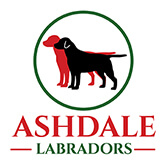


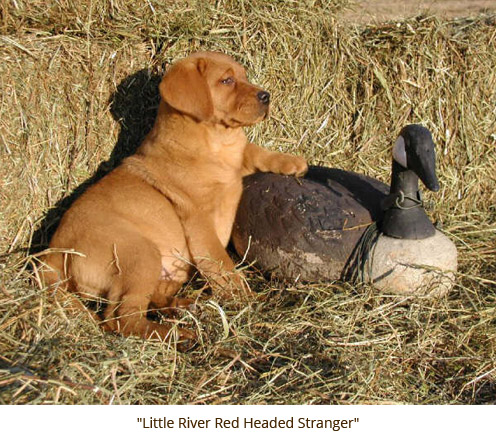
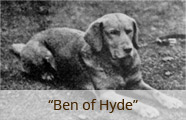 History of the Shade
History of the Shade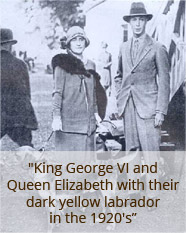 As the years passed, the lighter labradors became far more popular and people have lost sight of the true origin of the colour. Even today, it seems the lighter the shade of yellow, the better. Some breeders are now advertising White Labradors when in fact there is no such thing within the breed.They are following the trail of the lighter the better. Due to the lack of interest and popularity of the darkest shade of yellow in the labrador standard, it had all but disappeared.
As the years passed, the lighter labradors became far more popular and people have lost sight of the true origin of the colour. Even today, it seems the lighter the shade of yellow, the better. Some breeders are now advertising White Labradors when in fact there is no such thing within the breed.They are following the trail of the lighter the better. Due to the lack of interest and popularity of the darkest shade of yellow in the labrador standard, it had all but disappeared. The next step, again bringing in Balrion King Frost, was a breeding with Wynfaul Tobasco to Lady Bountiful of Balrion, herself a very dark yellow girl, daughter of Show Champion Balrion Kings Ransom, who was son of King Frost. The resulting litter was all fox red proving the Crooks theory of fox red to fox red will produce all fox red. Within this litter there was a red boy puppy sold to Sally Kelley of Kelleygreen Labradors in the United States, Balrion Red Alert.
The next step, again bringing in Balrion King Frost, was a breeding with Wynfaul Tobasco to Lady Bountiful of Balrion, herself a very dark yellow girl, daughter of Show Champion Balrion Kings Ransom, who was son of King Frost. The resulting litter was all fox red proving the Crooks theory of fox red to fox red will produce all fox red. Within this litter there was a red boy puppy sold to Sally Kelley of Kelleygreen Labradors in the United States, Balrion Red Alert.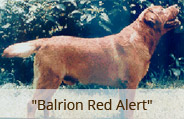 Another dog, while not being particularly famous himself, passed his influence on into the red bitch lines of both Kellygreen and Keepsake, was the fox red Scrimshaw Placido Flamingo. Tenor was bred by Barbara Barfield of Scrimshaw Labradors and was sired by CH Scrimshaw Duckless Fairbanks and was the grandson of the very famous CH Lindall Mastercraft. Tenor inherited the fox red shade from both sides of his pedigree, his grandfather, English Field Champion Venture of Brattonsplash and while his Dam was dark yellow, she had the red shade behind her. Tenor passed the fox red "C" Allele on to his offspring. When bred to kellygreens Lady In Red , they produced Keepsakes I Love Lucy, Dam of the AKC fox red champion, Keepsake Cajun. Not only did he give his shade to his decendants but also his wonderful laid back temperament. This big red dog was everything a Labrador should be, a true gentleman in every sense of the word.
Another dog, while not being particularly famous himself, passed his influence on into the red bitch lines of both Kellygreen and Keepsake, was the fox red Scrimshaw Placido Flamingo. Tenor was bred by Barbara Barfield of Scrimshaw Labradors and was sired by CH Scrimshaw Duckless Fairbanks and was the grandson of the very famous CH Lindall Mastercraft. Tenor inherited the fox red shade from both sides of his pedigree, his grandfather, English Field Champion Venture of Brattonsplash and while his Dam was dark yellow, she had the red shade behind her. Tenor passed the fox red "C" Allele on to his offspring. When bred to kellygreens Lady In Red , they produced Keepsakes I Love Lucy, Dam of the AKC fox red champion, Keepsake Cajun. Not only did he give his shade to his decendants but also his wonderful laid back temperament. This big red dog was everything a Labrador should be, a true gentleman in every sense of the word.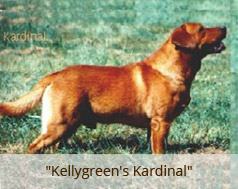
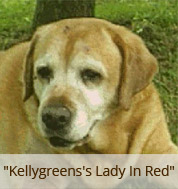
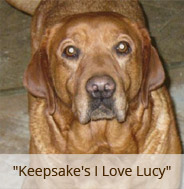
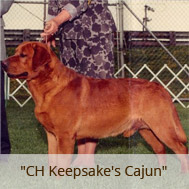

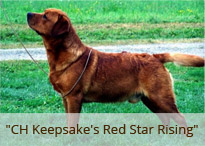
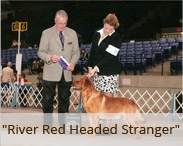
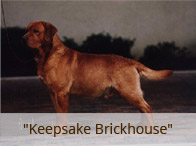
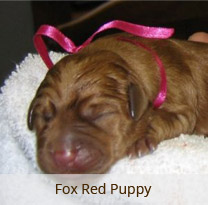 Normally when one thinks of a fox red labrador they think of a VERY DARK red. This may be true, but it is the shade that makes a fox red and they can appear both medium and dark. In all cases, the head and ears should appear red [again medium to dark] and based upon the coat type will determine how dark the body is. Many yellow labradors have what is called the CHINCHILLA effect where a hair shaft can be totally one colour or only a percentage of the guard hair reflects the colour. We have fox red labradors where only 20% of the end of the shaft shows the red colour. The head and ears were dark but the body looked medium at best and in fact some questioned if indeed they were fox red. One would only need to look close to see the red in the coat versus the dark honey brown of a normal yellow. It is the shade, NOT the degree of darkness that determines if the labrador is fox red or not. This "chinchilla effect" can vary greatly from dog to dog.
Normally when one thinks of a fox red labrador they think of a VERY DARK red. This may be true, but it is the shade that makes a fox red and they can appear both medium and dark. In all cases, the head and ears should appear red [again medium to dark] and based upon the coat type will determine how dark the body is. Many yellow labradors have what is called the CHINCHILLA effect where a hair shaft can be totally one colour or only a percentage of the guard hair reflects the colour. We have fox red labradors where only 20% of the end of the shaft shows the red colour. The head and ears were dark but the body looked medium at best and in fact some questioned if indeed they were fox red. One would only need to look close to see the red in the coat versus the dark honey brown of a normal yellow. It is the shade, NOT the degree of darkness that determines if the labrador is fox red or not. This "chinchilla effect" can vary greatly from dog to dog. The chances of white spots [chest, bolar pad and toes, etc] are much greater within the fox red shade than with other labrador colours.
The chances of white spots [chest, bolar pad and toes, etc] are much greater within the fox red shade than with other labrador colours.